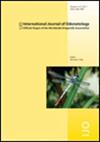泰国细纹灶神虫幼虫记述(兰布尔,1842)(合翅目:Caloptrygidae)
IF 1
4区 农林科学
Q3 ENTOMOLOGY
引用次数: 0
摘要
Vestalis gracilis (Rambur, 1842)是一种森林溪流豆娘,属于蝶科。它的最后一个体育场的幼虫和蜕皮描述和说明基于实验室饲养的标本从泰国,并提供了拮抗行为的观察。细叶螟幼虫的分类特征与阿米娜螟相似。它们具有突触性特征,如在臼后叶上有后向突起,正中板后缘斜截,唇端上有两具刚毛。牧尾草和芦花草有8个触角节,而阿米娜有7个触角节。薄叶草和绿叶草最显著的区别是绿叶草在臼后叶上有后外侧指向的突起,中间板的后缘斜截。本文章由计算机程序翻译,如有差异,请以英文原文为准。
Description of the larva of Vestalis gracilis (Rambur, 1842) (Zygoptera: Calopterygidae) from Thailand
Vestalis gracilis (Rambur, 1842) is a forest stream damselfly belonging to the family Calopterygidae. Its last-stadium larvae and exuviae are described and illustrated based on laboratory-raised specimens from Thailand, and observations of agonistic behavior are provided. The taxonomical characters of V. gracilis larvae are similar to those of V. amoena. They exhibit synapomorphic characters such as posterlaterally directed protuberances on the postocular lobes, posterior margin of median lamella obliquely truncate, and two setae on labial palps. Vestalis gracilis and V. luctuosa bear eight antennal segments whereas seven antennal segments are found in V. amoena. The most significant difference between V. gracilis and V. luctuosa is that V. luctuosa has posterolaterally directed protuberances on the postocular lobes and an obliquely truncate posterior margin of the median lamella.
求助全文
通过发布文献求助,成功后即可免费获取论文全文。
去求助
来源期刊

International Journal of Odonatology
ENTOMOLOGY-
CiteScore
2.30
自引率
0.00%
发文量
15
审稿时长
>12 weeks
期刊介绍:
International Journal of Odonatology (IJO) is aimed at providing a publication outlet for the growing number of students of Odonata. It will address subjects such as the ecology, ethology, physiology, genetics, taxonomy, phylogeny and geographic distribution of species. Reviews will be by invitation, but authors who plan to write a review on a subject of interest to the journal are encouraged to contact the editor.
 求助内容:
求助内容: 应助结果提醒方式:
应助结果提醒方式:


